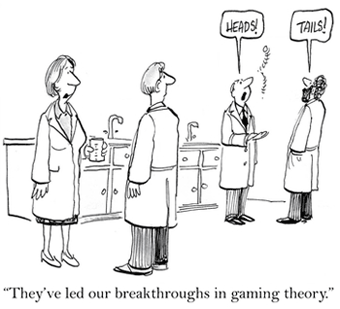For people who’ve watched the 2001 Russell Crowe starrer hit “A Beautiful Mind”, the name John Nash and the terms “Game Theory” and “Nash Equilibrium” would probably ring a bell. The most popular scene from the movie is probably where a group of guys are looking at a group of girls. All the guys prefer one of the girls; the blonde. Nash then describes how, if they all go for the blonde, they will block each other and none of them will get her. Going for her friends afterwards will not be the better choice because her friends will now be mad because they were the second choice. Nash proposes that they all start out by going for the friends such that they each get a girl and no one gets the blonde. Here’s the scene:
However I must warn you that in fact the scene depicts a Nash Equilibrium INCORRECTLY!!!!

A Nash Equilibrium is one where there can be no unilateral deviation i.e. each player is happy with his payoff (gain). In this case, however, there is an incentive for each of Nash’s friends to deviate i.e. leave the girl that they’ve chosen and go for the blonde.
 But enough of that. The objective of this article is not to undermine a multi Oscar winning movie but rather to see if Game theory, and in particular Cooperative Game theory model, can help us in assessing and improving a Supply Chain.
But enough of that. The objective of this article is not to undermine a multi Oscar winning movie but rather to see if Game theory, and in particular Cooperative Game theory model, can help us in assessing and improving a Supply Chain.
Basics of Game Theory
Game theory is the study of human conflict and cooperation within a competitive situation. It involves 2 or more participants (players) who are assumed to be rational and derive a certain gain/loss (payoff) in the different outcomes that results due to the occurrence of the game. Check out the links below for a better understanding.
http://www.investopedia.com/terms/g/gametheory.asp
http://www.investopedia.com/terms/p/prisoners-dilemma.asp

(You would have appreciated the joke more if you had actually gone through the links)
Application of Game theory to Supply Chain
We can make a distinction between decentralized and centralized supply chains. In case of the latter a single decision maker determines the optimal solution that improves the supply chain’s global performance.
In a decentralized supply chain, each supply chain member is an independent decision maker, and thus this situation can be modeled using Game theory where each member can be treated as a player.
An illustration of the application can be in transportation and logistics.

Unless a company has Santa as its logistics partner, the chances are that the logistics costs are pretty high (which is bad since transportation forms part of the 7 deadly wastes which add no value to the customer).
A research paper by Lotte Van Meirvenne calculates the total benefit that can be gained out by sharing of logistics providers by companies and so can logistics companies by coordinating among themselves better. But you already knew that companies can gain immensely by better coordination in the area of logistics (Duh!!).
However cooperative Game theory comes to the rescue to determine exactly how the total benefits can be divided among the players. This is done using something called a Shapley value.
http://www.investopedia.com/terms/s/shapley-value.asp
One can look at the savings in transportation and logistics as the spoils of a loot which is to be divided among the scurvy eyed pirates. The question of how to distribute gains in a multiplayer scenario is not a straightforward task and is one where Shapley value can be immensely helpful.

There are many instances where coordination between players of a supply chain can help in increased efficiency. These players can be in the same supply chain or competing supply chains. The benefits of cooperation are : elimination of excess inventory, reduction of lead times, increased sales, improved customer service, efficient product development efforts, low manufacturing costs, increased flexibility to cope with high demand uncertainty, increased customer retention and revenue enhancements.
The supply chain members can either compete to improve their individual performance or they could work together and make an agreement to coordinate their strategies in order to improve the global performance of the supply chain next to their own individual profits. In the cooperative situation, it is important that the benefits and costs are divided between the supply chain members in such a way that each member is satisfied; otherwise no supply chain member would be prepared to form a coalition.
The application of theoretical concepts for improving business efficiency is as important as the study of business processes to build up theoretical concepts. The article was aimed to bring out the continuum that exists between business and academia by showing its readers how a very relevant pain point in business can be solved by looking at seemingly unrelated theoretical models.
Leave an anonymous review/comment suggestion
https://goo.gl/forms/5Z8OSsfyOBtmCz7k1